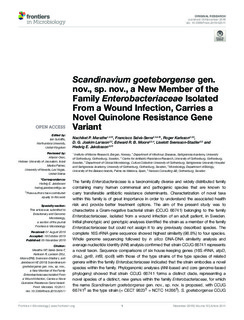| dc.description.abstract | The family Enterobacteriaceae is a taxonomically diverse and widely distributed family containing many human commensal and pathogenic species that are known to carry transferable antibiotic resistance determinants. Characterization of novel taxa within this family is of great importance in order to understand the associated health risk and provide better treatment options. The aim of the present study was to characterize a Gram-negative bacterial strain (CCUG 66741) belonging to the family Enterobacteriaceae, isolated from a wound infection of an adult patient, in Sweden. Initial phenotypic and genotypic analyses identified the strain as a member of the family Enterobacteriaceae but could not assign it to any previously described species. The complete 16S rRNA gene sequence showed highest similarity (98.8%) to four species. Whole genome sequencing followed by in silico DNA-DNA similarity analysis and average nucleotide identity (ANI) analysis confirmed that strain CCUG 66741 represents a novel taxon. Sequence comparisons of six house-keeping genes (16S rRNA, atpD, dnaJ, gyrB, infB, rpoB) with those of the type strains of the type species of related genera within the family Enterobacteriaceae indicated that the strain embodies a novel species within the family. Phylogenomic analyses (ANI-based and core genome-based phylogeny) showed that strain CCUG 66741 forms a distinct clade, representing a novel species of a distinct, new genus within the family Enterobacteriaceae, for which the name Scandinavium goeteborgense gen. nov., sp. nov. is proposed, with CCUG 66741T as the type strain (= CECT 9823T = NCTC 14286T). S. goeteborgense CCUG 66741T carries a novel variant of a chromosomally-encoded quinolone resistance gene (proposed qnrB96). When expressed in Escherichia coli, the qnrB96 gene conferred five-fold increase in minimum inhibitory concentration against ciprofloxacin. This study highlights the importance and the utility of whole genome sequencing for pathogen identification in clinical settings. | nb_NO |
